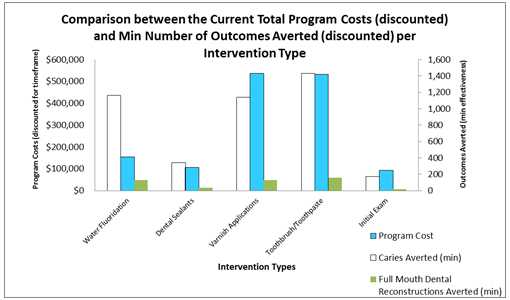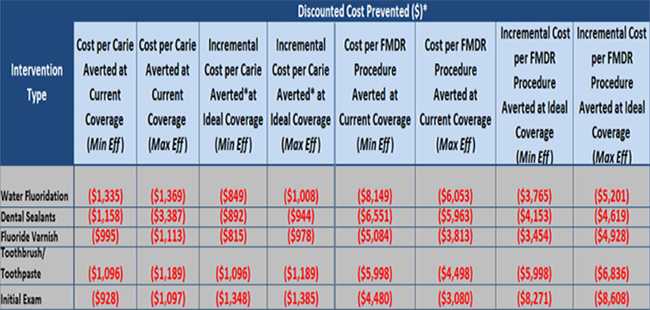Dental Caries
Cost Effectiveness of Dental Interventions for Alaska Native Children
Tooth decay or dental cariesa is one of the most common chronic conditions among American children as reported by the American Academy of Pediatrics Children’s Oral Health Initiative (1, 2). In April 2008, the Arctic Investigations Program of the Centers for Disease Control and Prevention (CDC-AIP) was informed of high rates of dental caries among Alaska Native (AN) children residing in the Yukon–Kuskokwim Delta (YKD) region of Alaska. A public health assessment was conducted that showed high rates of caries and a frequent need for full mouth dental reconstructions (FMDRs)b. Caries were most strongly associated with lack of optimally fluoridated drinking water and soda consumption (3, 4, 5).
CDC was asked by the YKD Dental program for technical assistance in determining whether current interventions were cost-beneficial and effective in reducing the number of carious teeth in YKD children. In response, researchers examined, from the healthcare payer (i.e., Medicaid) perspective, the impact of five interventions currently used among YK children: water fluoridation, dental sealants, fluoride varnish, brushing with fluoride toothpaste, and initial dental exam with parental counseling. Through an extensive literature review, researchers determined the effectiveness rates (minimum and maximum) and the current and ideal coverage levels for each intervention (6).These data may aid public health officials and primary dental care providers to choose those interventions likely to have the greatest impact in reducing rates of dental caries in this population.

The figure above displays a comparison between current total program costs (discounted) and minimum number of outcomes averted (discounted) per intervention type
Researchers presented a comparison between program cost and the minimum number of health outcomes prevented over a 10-year timeframe (See figure above). For instance, over a 10-year time period, the cost of water fluoridation would be ~$150,000, whereas fluoride varnish would bet ~$500,000. Both interventions are estimated to prevent ~1,200 dental caries and ~100 FMDRs, representing a ~$1.7 million cost savings for the healthcare payer. While both interventions prevented a similar clinical outcomes, the 10-year water fluoridation program would cost considerably less than a 10-year fluoride varnish program.
Key Findings:
- Of the five interventions studied, water fluoridation, tooth brushing and fluoride varnish would prevent the greatest number of dental caries and FMDRs.
- All five interventions produced a cost savings to the healthcare payer, but the level of cost saving is dependent on the intervention chosen (See model below). When examining the greatest cost benefit, researchers found the following based on expected minimum and maximum effectiveness rates (numbers of cases averted):
- At its minimum expected effectiveness, water fluoridation had the greatest cost benefit of preventing dental caries with a savings to the healthcare system of $1,335 per averted carie.
- At its maximum expected effectiveness, dental sealants had the greatest cost benefit in preventing caries with a savings of to the healthcare system of $3,387 per averted carie.
- In addition, when examining the prevention of caries in children receiving full mouth dental reconstruction, water fluoridation also had the greatest cost benefit with a savings to the healthcare system of $8,149 per FMDR averted at minimum effectiveness, and a savings of $6,053 per case averted at maximum effectiveness.
Cost Prevented per Intervention Type, Yukon-Kuskokwim Health Corporation, Alaska

Cost Prevented per Intervention Type, Yukon-Kuskokwim Health Corporation, Alaska The model above examines the (discounted*) cost for each type of dental intervention at minimum and maximum effectiveness levels.
NOTE: The values presented in parenthesis indicate a cost savings in the amount presented. For instance Water Fluoridation’s cost benefit of preventing dental caries in Alaska native children (6months- 5 years) saved the health care system $1,335.
*We applied 3% discount rate (per year) on the current year values to estimate all future costs and benefits.
Download Available [XLS – 511 KB]
- Dental caries are bacterial infected tooth surfaces, which destroy the tooth enamel resulting in tooth decay. The treatment of these teeth may be done either in the local dental office by a dentist or dental provider or by an oral surgeon in the operating room when a child is unable to withstand treatment in the dental office and thus needs to be placed under anesthesia.
- Full mouth dental reconstructions (FMDRs) are procedures done by an oral surgeon in the hospital operating room while the patient is under sedation or general anesthesia. FMDRs are recommended for children with extensive dental disease. Examples of procedures done under general anesthesia are extractions, restorations (i.e., crowns, fillings), and pulpotomies.
References
- American Academy of Pediatric Dentistry. Policy on Early Childhood Caries (ECC): Unique Challenges and Treatment Options. Pediatric Dentistry.2009;31(6):44-46.
- American Academy of Pediatrics. Early Childhood Caries in Indigenous Communities. Pediatrics. 2011;127(6):1190-1198.
- Byrd K, Bruce M, Hennessy T. Arctic Investigations Program’s Investigation of Dental Caries in AN Children. 2009. Unpublished report.
- Centers for Disease Control and Prevention. Dental Caries in Rural Alaska Native Children – Alaska, 2008. MMWR Weekly, 2011;60(37):1275-78.
- Arctic Investigations Program. YK Dental Frequency, Number of Dental Procedures Completed in YK. 2011. Unpublished data.
- Atkins CY, Thomas TK, Lenaker D, Day GM, Hennessy TW, Meltzer MI. Cost-effectiveness of preventing caries and full mouth dental reconstructions among Alaska Native children in the Yukon-Kuskokwim Delta region of Alaska. J Public Health Dent. 2016 Jun;76(3):228-40. doi: 10.1111/jphd.12141. Epub 2016 Mar 15.
- Page last reviewed: February 8, 2017
- Page last updated: February 8, 2017
- Content source:


 ShareCompartir
ShareCompartir